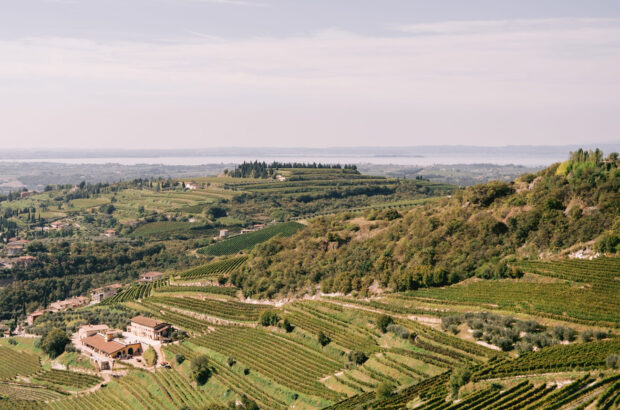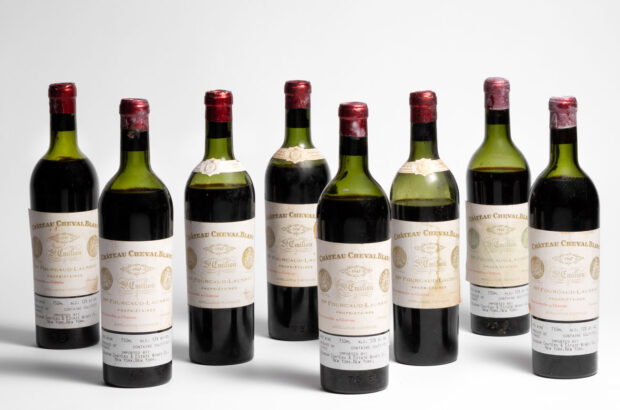Situated between 32 ̊ and 42 ̊ north, Greek vineyards are some of the world’s hottest. While this might suggest a preference for growing black grapes, red wine only accounts for one third of Greek output. According to the International Organisation of Vine and Wine (OIV), overall production in 2022 was one of the lowest recorded in decades (down 14% from 2021, to 2.1 million hectolitres), though white wine still has the majority share, accounting for around 60% of volume.
The wide variety of microclimates throughout the mountainous country – ranging from high altitudes to coastal and island vineyards that cool and extend the growing season – create the perfect conditions to produce Greece’s famous zesty, energetic, mineral-driven white wines along with approachable, fruity and floral thirst-quenchers.
Greek whites: Where to find them
Some of Greece’s white wine highlights can be found in regions including Macedonia, the Peloponnese and Santorini.
Moving north to south, the mountainous region of Macedonia covers the largest part of northern Greece and contains two leading PDOs, Naoussa and Amynteo. At their high altitudes (some exceeding 700m above sea level) grapes ripen more slowly in these cooler terroirs, developing more interesting flavours as a result.
While they are both exclusively red wine PDOs, there are exceptional white wines to be found in Florina and Drama in Macedonia from Malagousia and Assyrtiko grapes.
The upside down hand-shaped peninsula in the south is the Peloponnese. With the largest vineyard plantings in Greece, the Peloponnese is responsible for around 30% of the nation’s wine, producing every style from sparkling to fortified.
Nemea and Mantinia are especially prestigious PDOs of this region, both reaching high altitudes of 800m – edging towards the Aegean sea – and producing exceptional wines. While Nemea is a PDO for reds, Mantinia is a PDO for white wines, where the pink-skinned Moschofilero must legally make up at least 85% of the blend for the dry white wines.
Roditis is commonly found here too, where it can appear as a modest (if somewhat bland) white wine, but is increasingly used for more modern and complex wines, too.
Island viticulture in Greece dates back to antiquity, and it is these regions where strong, onshore winds – especially on the Cyclades islands, such as Santorini – result in the famous mineral-driven, saline and acidic white wines.
Relentless Aegean gales and merciless droughts provide challenging viticultural conditions for growers. Yet they persist in working their basket-trained vines with pride, some of which date back 200 years on their original roots where the volcanic soils are phylloxera free. All this results in extremely low yields (due to a combination of very old vines and very difficult conditions), yet demand continues to grow, in turn pushing up prices for Greek island wines.
The white varieties
Around 300 indigenous grape varieties constitute 90% of plantings. Sure, many of them are unpronounceable to the average wine consumer, adding a significant challenge in marketing the wines internationally. But the adventurous drinker will delight in bypassing the Chardonnay and Pinot Grigio in favour of any one of these Greek wonders.
The best-known Greek white wines are undoubtedly Retsina and Assyrtiko. Retsina is famous for historical reasons and has an unarguably chequered reputation, long associated with inferior wine often made from a blend of grapes and masked by pine resin flavours. Traditionally Savatiano (along with Roditis) is the main grape in Retsina wines. Widely planted for its high yields and drought resistance, Savatiano has been a natural choice for producers churning out cheap and simple white wines over the past decades. However, winemakers like Papagiannakos Winery and Muses Estate are seeking out older vines with lowered yields to produce high-quality contemporary wines.
Assyrtiko is Greece’s best success story. Originally from Santorini, now internationally acclaimed, Assyrtiko is widely planted on mainland Greece as it has proven to be drought resistant while retaining freshness when ripe. The flavour concentration intensifies with older vines, and this, coupled with the razor-sharp acidity gives the wines spectacular power and ageability. Assyrtiko is also used to produce sweet wines, such as Vinsanto from Santorini.
Lovers of Viognier or Muscat will feel at home with Moschofilero. This aromatic variety serves up fragrant floral, citrus and spice notes. Usually a lighter body style, with medium alcohol and best enjoyed fresh. Its pink skin means it can also appear as rosé wine with extended skin contact, and even give a blush hue to white wines.
Malagousia went from unfashionable to high profile in recent decades with plantings now popping up all over Greece. Its softer acidity has inspired savvy winemakers to blend it with Assyrtiko, while others bottle it as a single varietal embracing its pronounced nectarine, honeysuckle and rose petal profile. High altitudes, cooler sites, or early picked grapes show a green herbal edge, not unlike Sauvignon Blanc; Alpha Estate Malagouzia, Single Vineyard ‘Turtles’, grown at over 600m above sea level is a perfect example of this racier style.
Though it’s the indigenous grapes of Greece that are most interesting to discover, international varieties such as Chardonnay, Viognier and Sauvignon Blanc are ever prevalent. The best examples are when they have been blended with local varieties such as Cavino’s Mega Spileo Cuvée III White blend of Assyrtiko, Malagousia and Chardonnay.
These exciting exotic grapes, varied terroirs, and soaring quality levels are why consumers will not be bored spending their summer exploring Greek wine gems.








